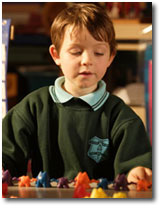Counting On: 1.5
Supporting materials
Indicator of Progress

Students can count on from one number when finding the total of two collections, which they may have already counted.
The next step is to realise that it is better to count on from the larger of the two numbers. Previously, students will find the total of two collections by recounting all the objects.
More about counting on and counting all.
Illustration 1: Diagnosing stages
There are three common stages in this developmental sequence:
- count all
- count on
- count on from larger.
Put some Unifix on the table, all the same colour. Ask the students to make a tower using 6 Unifix. Stand the tower behind a barrier, where the top can still be seen but the lower blocks cannot. Make another tower using 3 blocks of a different colour. Put it on top of the other tower. Ask “How many blocks are in the tower altogether? Please explain how you worked it out.”
1. If the student cannot work out the answer, remove the barrier, and ask them to work out how many there are altogether. This student is likely to be at the count all stage.
To find the total of items in two collections, most students go through a phase where they count both collections individually, and then count all the items together a second time. This is called “counting all”.
2. If students remember there were 6 counters originally and count (6), 7, 8, 9, we say they are able to count on.
3. For those students who can count on, start with a tower of 3 blocks, hidden, add to it another tower of 6 blocks, and ask them to work out the total. Students who say ‘I can see 6 blocks, there were three before’ and then counts ‘ (6), 7, 8, 9’ are able to count on from the larger number.
For efficient calculation later on, it is essential that students recognise the 3 + 6 is the same as 6 + 3 and find the total of the collection by counting on from the larger number. So they calculate 3 + 6 not by counting (3), 4, 5, 6, 7 ,8, 9 but by switching to 6 + 3 and counting (6), 7, 8, 9.
Illustration 2

Examples of the types of tasks that would be illustrative of counting on concepts, aligned from the Mathematics Online Interview:
- Question 2 (a) (b) - Counting by 1s
- Question 18 - I have 9 teddies and you have 4 teddies. How many teddies do we have altogether?
Teaching Strategies
The strategy for assisting students to progress to counting on is to use situations with hidden objects, so that children are not able to count all easily.
Activity 1: Teddies in the buses aims to encourage counting on, requiring memorisation of the starting number.
Activity 2: Counters in the bag and in the hand is similar, and enables comparisons.
Activity 1: Teddies in the buses
Have a bus that can hold 8 teddies. The students place 8 teddies in the bus. Have another bus with 5 teddies. Drive one bus away so that the students can no longer see it. Ask them to work out how many teddies have caught the two buses.
This activity encourages the students to remember, and count on from the number of teddies in the bus that left. Initially the bus with more teddies can leave. After the students are familiar with the situation, then have the bus with fewer teddies leave.
Activity 2: Counters in the bag and in the hand
Put some counters in a bag counting them out aloud one by one as you put them in. Each student picks up a handful of counters from the table. They guess how many they have in their hand and then count them. Ask each student to calculate how many counters would be in the bag, if they put their handful in as well.
The student can see that you are not going to show the counters in the bag, and they must work out a way to find the total without looking into the bag. Since each student may have a different number of counters in their hand there will be an opportunity to discuss the different strategies used. There will also be plenty of opportunity to reinforce counting on as different students have a turn, and everyone can count on together.
As a group activity, many opportunities for repetition of the strategy and for group discussion will arise. For example: we have just found out that if Sara's 4 counters were added to the bag, then there would be 11. James has one less counter than Sara. How many there will be if we add James' to the bag instead?
Teaching Strategies
The following resource contains sections that may be useful when designing learning experiences:
Digilearn object *
Number trains – students arrange train carriages according to numbers on their sides. The numbers are represented in a range of formats such as words, numerals, dice dots or counting frames. Students identify the numbers that come before and after starting numbers.
(https://www.eduweb.vic.gov.au/dlr/_layouts/dlr/Details.aspx?ID=4453)
* Note that Digilearn is a secure site; SMART::tests login required.
